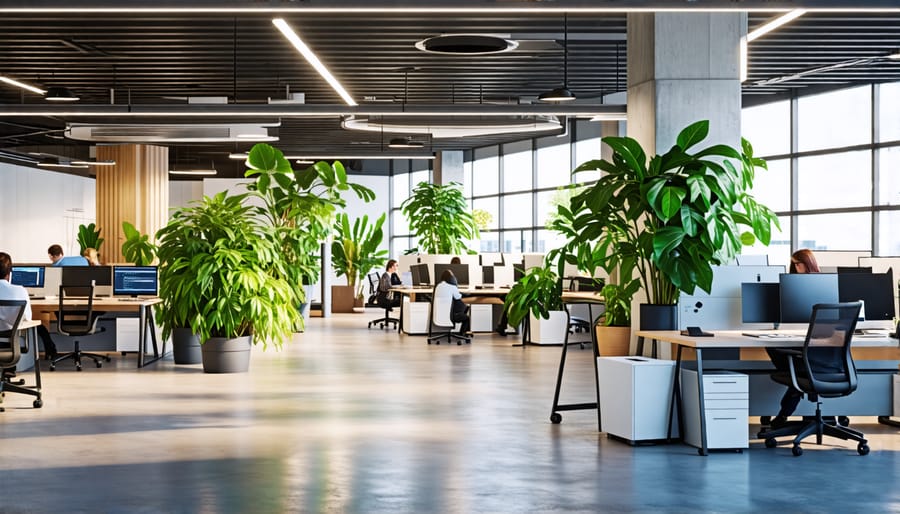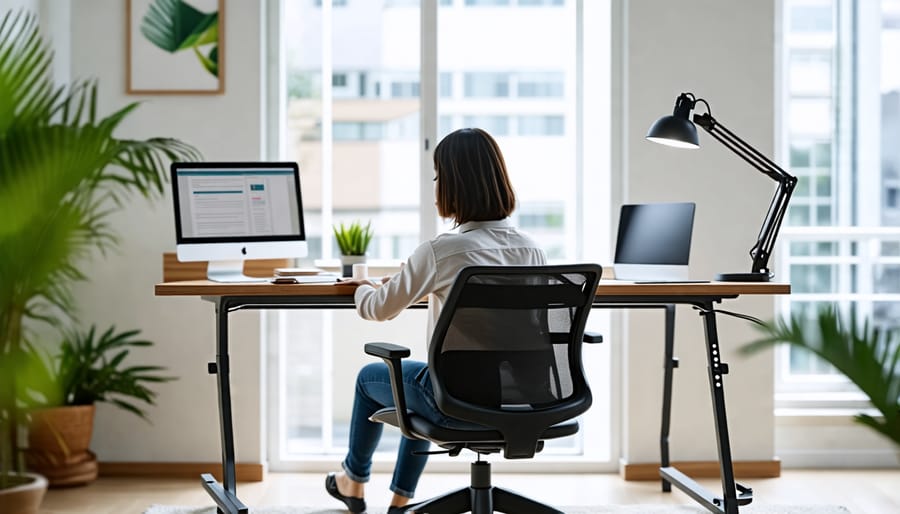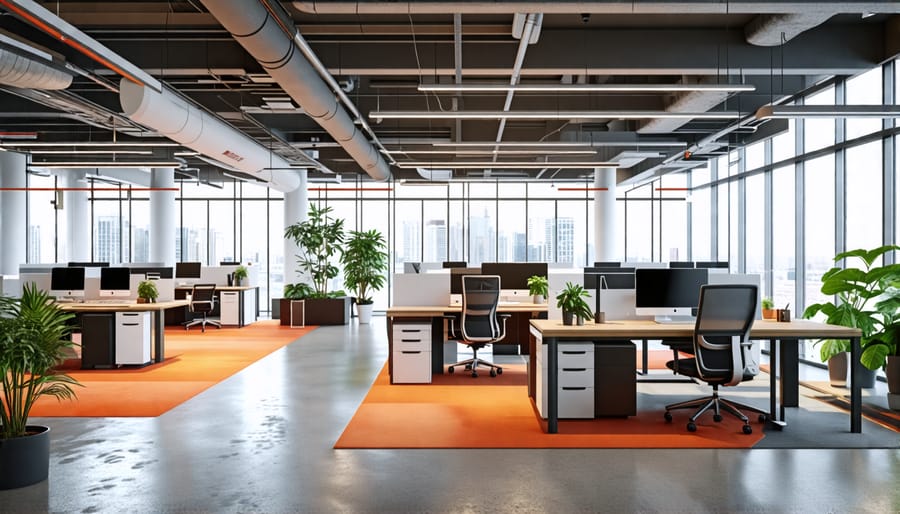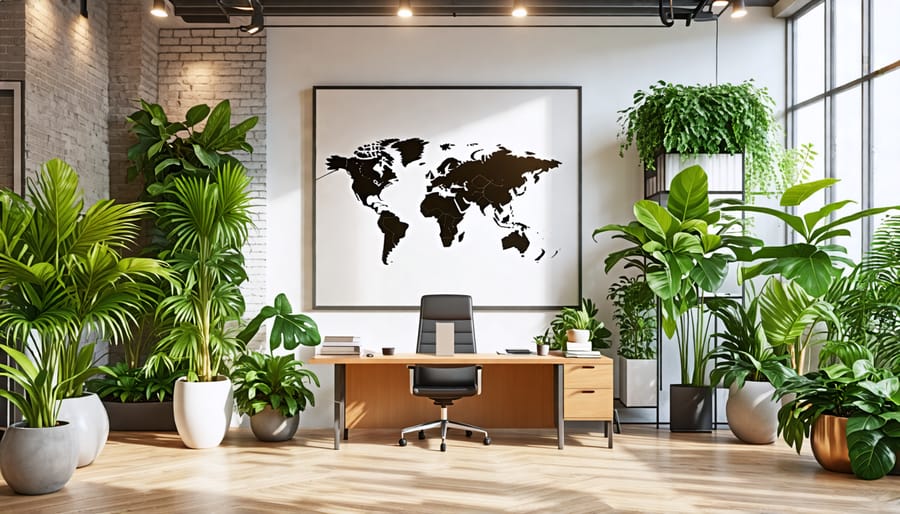
7 Essential Elements of a Quality Office Environment
Create an office environment that promotes the health, happiness and productivity of your team:
Optimize lighting, temperature, air quality and ergonomics to maximize comfort and performance. Invest in adjustable desks, supportive chairs, glare-free lighting and green plants.
Foster collaboration and creativity with flexible workspaces. Provide a mix of open areas, private offices, huddle rooms and lounge spaces to support different work styles and activities.
Integrate technology seamlessly to enable mobility and productivity. Equip the office with fast WiFi, ample power outlets, wireless charging, digital whiteboards and up-to-date software.
Cultivate your company culture and values through workspace design. Showcase your brand, celebrate achievements, display your mission statement and core values. The office environment should reflect who you are.
Investing in a quality office space delivers proven benefits – boosting morale, wellbeing, efficiency and talent retention. Create a space where your team can thrive.
Ergonomic and Functional Furniture
Creating an ergonomic and functional office space is essential for promoting comfort, productivity, and overall well-being. When selecting office furniture, prioritize pieces that offer adjustability and support to accommodate a range of body types and working styles. Desks with height-adjustable options allow for easy transitioning between sitting and standing positions throughout the day, reducing the negative effects of prolonged sitting. Ergonomic chairs should provide ample lumbar support, adjustable armrests, and seat height options to ensure proper alignment and reduce strain on the back, neck, and shoulders.
When arranging your office layout, consider the flow of movement and the specific needs of each workstation. Position frequently used items, such as printers or filing cabinets, within easy reach to minimize unnecessary stretching or twisting. Incorporate storage solutions that keep workspaces clutter-free and organized, as a tidy environment can boost focus and productivity.
Investing in functional furniture extends beyond individual comfort; it also contributes to the overall aesthetics and professionalism of your office. Sleek, modern pieces can create a polished look that impresses clients and boosts team morale. When making furniture choices, consider the balance between style and practicality, opting for pieces that are both visually appealing and built to withstand daily use.
Remember, creating an ergonomic and functional office space is an ongoing process. Regularly assess your furniture and layout, making adjustments as needed to ensure optimal comfort and efficiency. By prioritizing ergonomics and functionality in your office design, you’ll foster a work environment that promotes health, happiness, and success.

Optimal Lighting and Temperature
Lighting and temperature play a crucial role in creating a productive office environment. Poor lighting can lead to eye strain, headaches, and fatigue, while extreme temperatures can cause discomfort and decreased focus. The ideal lighting setup combines natural daylight with well-positioned artificial light sources. Aim for a mix of ambient, task, and accent lighting to create a balanced and inviting atmosphere. Consider installing adjustable blinds or shades to control glare and brightness throughout the day.
When it comes to temperature, the sweet spot for productivity lies between 68°F and 76°F (20°C to 24°C). To maintain a consistent temperature, invest in a programmable thermostat that automatically adjusts based on occupancy and time of day. Ensure your HVAC system is properly maintained and consider adding fans or portable heaters for individual comfort preferences.
Don’t forget about air quality, either. Regular cleaning, proper ventilation, and the use of air purifiers can help remove pollutants and keep the office fresh. Incorporating plants is another natural way to improve air quality while adding a touch of biophilic design. By prioritizing optimal lighting and temperature in your office, you’ll create an environment that promotes comfort, focus, and overall wellbeing for everyone.
Effective Space Planning
When designing an office environment, effective space planning is crucial to maximize efficiency and collaboration while promoting employee wellbeing. The foundation of a well-planned office layout is understanding the specific needs of your team and the nature of their work.
Start by considering the balance between individual workspaces and collaborative areas. Open floor plans have gained popularity for fostering teamwork, but it’s essential to provide a mix of private and shared spaces to accommodate different work styles and tasks. Modular furniture, movable walls, and flexible seating arrangements allow for easy reconfiguration as needs change.
To encourage collaboration, strategically place communal areas like break rooms, lounges, and meeting spaces in central locations. These shared spaces should be inviting and equipped with comfortable seating, whiteboards, and technology for seamless idea-sharing.
When arranging individual workstations, prioritize ergonomics and functionality. Adjustable desks and chairs, along with proper lighting and storage solutions, can enhance comfort and productivity. Position desks to maximize natural light and minimize glare from windows or overhead fixtures.
Consider the flow of foot traffic and ensure clear pathways between workstations, meeting rooms, and common areas. Use plants, partitions, or other design elements to define spaces and provide visual interest without impeding movement.
Technology integration is another key aspect of modern office space planning. Incorporate ample power outlets, charging stations, and data ports to support the use of laptops, smartphones, and other devices. Invest in reliable wireless internet and consider implementing smart technology for effortless control of lighting, temperature, and audio-visual equipment.
By thoughtfully planning your office layout, you can create a functional, inspiring environment that empowers your team to do their best work.

Inspiring Colors and Decor
Colors and decor play a significant role in creating an inspiring office environment that boosts mood, creativity, and productivity. Understanding color psychology can help you choose hues that evoke the desired atmosphere. For a calming and focused vibe, consider cool tones like blues and greens, which are known to reduce stress and improve concentration. Warmer colors like yellows and oranges can stimulate creativity and enthusiasm, making them ideal for collaborative spaces or brainstorming areas.
When selecting a color palette, balance is key. Opt for a primary neutral tone for walls and larger surfaces, then introduce accent colors through furniture, artwork, and accessories. This allows for flexibility and easy updates as trends or needs change. Incorporating natural elements like wood, plants, and organic textures can also enhance the overall ambiance and connection to nature.
Lighting is another crucial aspect of office decor. Maximize natural light by keeping windows unobstructed and using sheer or light-filtering window treatments. For artificial lighting, choose a mix of overhead fixtures and task lamps to create a layered, adjustable illumination scheme that reduces eye strain and headaches.
Finally, personalize the space with inspirational artwork, motivational quotes, and unique decor pieces that reflect your company’s values and culture. Allowing employees to add their own touches, such as photos or small trinkets, can boost morale and create a sense of ownership and pride in their work environment.
Biophilic Design Elements
Biophilic design brings the calming, restorative effects of nature into the built environment. By incorporating natural elements, patterns, and processes, biophilic design can reduce stress, enhance creativity, and improve overall wellbeing in the workplace. One simple way to embrace biophilic design is by adding plants to your office space. Potted plants, living walls, or even small indoor gardens can purify the air, regulate humidity, and create a visually appealing, soothing atmosphere. Natural materials like wood, stone, and organic fabrics can also help establish a connection with nature. Consider using wood flooring or furniture, stone accents, or textiles with nature-inspired patterns. Maximizing natural light through strategic window placement and using light-colored walls can further enhance the biophilic effect. Water features, such as small fountains or aquariums, can provide a calming auditory and visual experience. Even artwork depicting natural scenes or fractal patterns can contribute to a biophilic environment. By thoughtfully integrating these elements, you can create an office space that promotes wellbeing, productivity, and a sense of connection to the natural world.

Noise Control and Privacy
Noise and distractions are the bane of productivity in any office environment. Luckily, there are several effective strategies to minimize disruptions and enhance privacy. Installing acoustic panels on walls and ceilings can significantly reduce echoes and absorb excess sound. These panels come in various colors and designs to match your office aesthetic. Another option is to use white noise machines or even nature sound apps to mask distracting conversations and create a more soothing ambiance. For visual privacy, consider installing frosted glass partitions or using room dividers to create separate work zones. Plants can also serve as natural barriers while purifying the air. Implementing a “quiet zone” policy in certain areas can encourage employees to respect others’ need for focused work time. By combining these strategies, you can create a more peaceful and productive office environment that promotes concentration and wellbeing.
Conclusion
Creating a quality office environment involves focusing on seven key elements: ergonomic workstations, lighting, air quality, acoustics, biophilic design, breakout spaces, and technology integration. By investing in each of these areas, companies can foster a workspace that promotes employee wellbeing, productivity, and overall success. While upgrading an office may seem like a significant expense, the return on investment is clear: happy, healthy employees are more engaged, creative, and efficient. Moreover, a well-designed office can help attract and retain top talent, reduce absenteeism, and improve the company’s bottom line. In today’s competitive business landscape, creating a quality office environment is not just a nice-to-have – it’s a strategic necessity.
